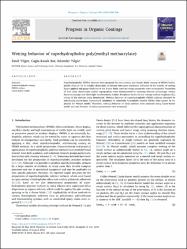Wetting behavior of superhydrophobic poly(methyl methacrylate)
Abstract
Superhydrophobic PMMA surfaces were prepared by spin-coating and doctor blade coating of PMAA/hydrophobic silica (1/10 by weight) dispersions in toluene onto glass substrates. Influence of the number of coating layers applied and gauge thickness of the doctor blade used on surface properties were investigated. Formation of dual scale, micro/nano surface topographies were demonstrated by scanning electron microscopy, atomic force microscopy and white light interferometry studies. Roughness factor (r) and average surface roughness (Ra) values of the surfaces were determined. Wetting behavior of superhydrophobic PMMA surfaces obtained by introducing micro-nano, hierarchical roughness to inherently hydrophilic smooth PMMA films cannot be explained by Wenzel model. Therefore, wetting behavior of these surfaces were analyzed using Cassie-Baxter model and area fraction of surface protrusions were estimated.

















